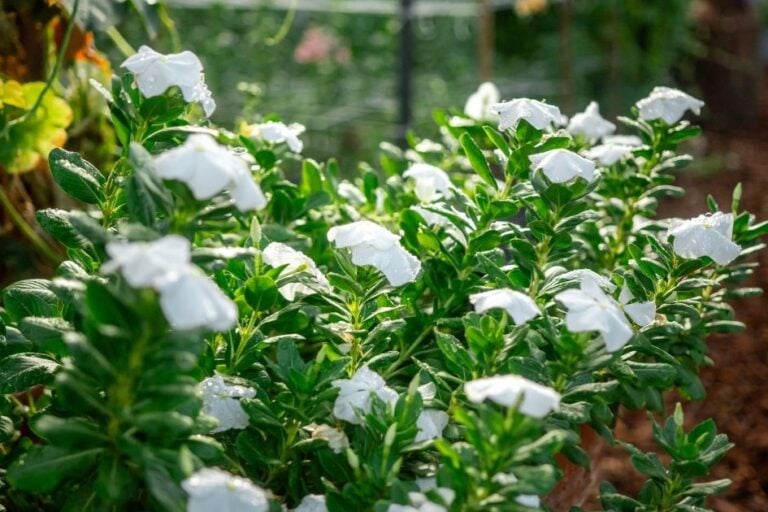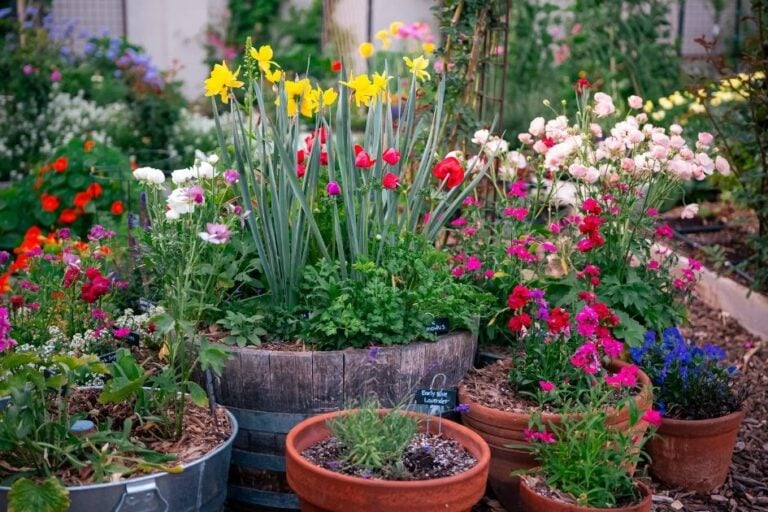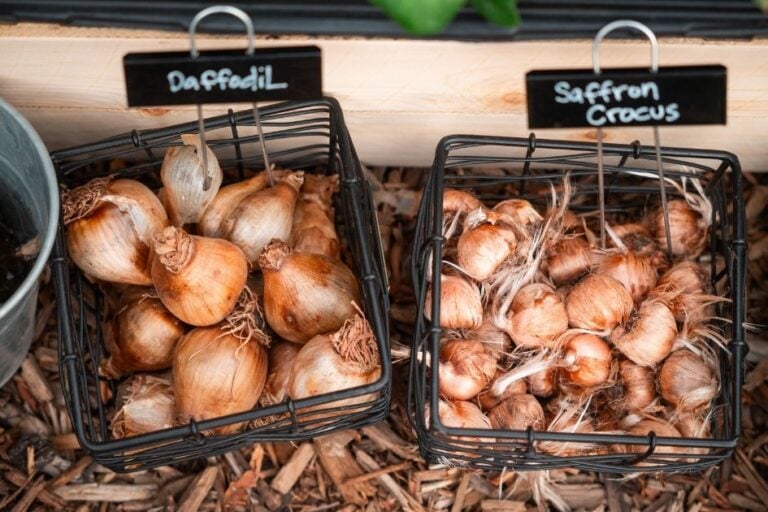How to Grow Hollyhocks
Hollyhocks are a beloved addition to the garden. They offer tall, striking flower stalks that bloom from the bottom up, providing a prolonged display of color. Follow these tips to learn how to grow healthy hollyhocks, attract pollinators, and ensure a thriving plant year after year. Keep reading for extra tips about how to grow hollyhocks in Arizona and other hot summer climates.

Article Outline:
- Understanding Hollyhocks: Biennial or Perennial?
- Ideal Growing Conditions for Hollyhocks
- When to Plant Hollyhocks in Different Climates
- Using Hollyhocks in the Garden
- How to Grow Healthy Hollyhocks and Encourage More Blooms
- Preventing and Treating Rust on Hollyhocks
- What to Do After Hollyhocks Flower
- How to Grow Hollyhocks in Arizona
Understanding Hollyhocks: Biennial or Perennial?
Although some hollyhocks bloom the first year, many are biennials. Bienniel hollyhocks produce clumps of leaves and strong roots in the first season. The following year, they send up tall flowering stalks, produce seeds, and die. However, hollyhocks often appear to be perennials in the garden because they readily reseed themselves, allowing new plants to emerge each year. Here’s what to expect from biennial hollyhocks:
- First Year: Germination, root development, and leaf growth.
- Second Year: Flowering, seed production, and then plant death.
Tip: Allow seeds to fall naturally around plants. These self-sown seedlings can help make hollyhocks a permanent feature in your garden.
Ideal Growing Conditions for Hollyhocks
Hollyhocks thrive in sunny locations with moist, fertile, well-drained soil. They also grow in areas with less fertile soil.
Here’s how to ensure your hollyhocks grow well:
Plant seeds no more than ¼ inch (6 mm) deep. Amend the soil with compost each spring for added nutrient. Space plants about 2 feet (60 cm) apart to promote good air circulation. Water deeply to help establish long taproots, then allow the top several inches to dry out before watering again.

When to Plant Hollyhocks in Different Climates
Low Desert of Arizona:
- Start seeds indoors: August–January.
- Plant seeds or transplants outdoors: October–March.
Cooler Climates:
- Start seeds indoors: 9–10 weeks before the last expected frost in spring.
- Plant seeds or transplants outdoors: 2–3 weeks after the last frost when the soil has warmed.
Mild Climates:
- Start seeds indoors: Early spring (February–April).
- Plant seeds or transplants outdoors: March-May, depending on the last frost date.
Using Hollyhocks in the Garden
Hollyhocks attract hummingbirds and butterflies and serve as host plants for caterpillars. Due to their height (up to 10 feet/3 meters), hollyhocks make a striking addition to the back of a border garden or against walls. Their tall stalks provide a lovely backdrop for roses, larkspur, dianthus, and bachelor’s buttons.
Hollyhock flowers can be single or double, with colors ranging from pink, white, yellow, and red to nearly black. Choose varieties based on the desired height and flower form for your garden.

How to Grow Healthy Hollyhocks and Encourage More Blooms

To get the best out of your hollyhocks, follow these tips:
Amend the soil with compost each spring to encourage strong growth. Pinch or trim off faded blooms before seed pods form. This encourages the plant to produce more flowers instead of focusing on seed production. Remove damaged or dead leaves regularly to keep the plant looking its best and reduce disease risk.
Hollyhocks bloom in late spring through summer, depending on your climate. In some regions, blooms may continue into early fall.
Preventing and Treating Rust on Hollyhocks
Rust is a common problem for hollyhocks, but with proper care, you can minimize its impact:
- Watering: Water at ground level to avoid wetting the leaves.
- Spacing: Keep plants about 2 feet (60 cm) apart for good air circulation.
- Cleaning: Remove and discard affected leaves (do not compost them). Clear debris around the plants and remove weeds that could harbor disease.
- Treatment: Organic fungicides like sulfur or copper can help if you need to treat the plants. Remove heavily-infested plants to prevent the spread of rust.
What to Do After Hollyhocks Flower
After your hollyhocks have finished blooming, follow these steps to prepare for the next season:
If you want more hollyhocks next year, allow some stalks to produce and drop seeds in place. Prune flower stalks back to about 6 inches (15 cm) above the ground to tidy up the plant and encourage future growth.

To save seeds, wait until the seed pods are completely dry and brown, then collect them for sharing or planting in other parts of the garden. See my seed-saving guide here.
Divide and transplant smaller self-sown plants from around the base. Keep in mind that self-sown hollyhocks may not resemble the parent plant.

How to Grow Hollyhocks in Arizona
Hollyhocks can be a stunning addition to an Arizona garden if you know how to handle the extreme desert climate. Here are some Arizona-specific growing tips:
- Seed Starting Indoors: Start hollyhock seeds indoors during these windows:
- Transplanting Outdoors: Plant seeds or transplants outdoors:
The stalks will be taller if you plant earlier in the planting window.
In Arizona’s low desert, hollyhocks bloom from April through June or July. After blooming, prune spent stalks back to about 6 inches (15 cm) and remove plant debris to discourage pests. Late fall is the best time to divide and replant hollyhocks, as cooler temperatures help them establish before the next growing season.
Sunlight Needs: Hollyhocks thrive in morning sun or filtered afternoon sun in Arizona. Avoid planting them against west-facing walls, as the intense afternoon heat can be too much for the plants to survive after blooming. North-facing walls often provide the ideal conditions for hollyhocks in hot desert climates.
Following these guidelines, you can enjoy beautiful hollyhocks year after year, even in challenging climates like Arizona’s low desert.

By properly caring for hollyhocks, including encouraging reseeding and managing rust, you can ensure they remain a standout feature in your garden. Hot climate growers, be sure to follow the extra growing tips for Arizona, and with the right location and care, these towering beauties will flourish season after season.
Want to add more color to your garden with flowers?

Arizona annual flowers planting guide helps you learn when to plant flowers in Arizona, and whether to plant seeds or transplants.









Thanks a lot on info
most informative article about growing hollyhocks i have seen yet. And the pictures are very useful, it shows exactly what the author is explaining. finally, it is nice to read about planting flowers from the same region; i live in new mexico.
I’m so glad the information was helpful. Best of luck to you with your garden.
Me encantan este tipo de plantas Hollyhocks me parece divinas, agradezco mucho la información al respecto, me encantaría por comprarlas; yo vivo en el Estado de Hidalgo, México.
Eres muy bienvenido. Estoy muy contento de que haya sido útil. Hola de Arizona.
Me encantan este tipo de plantas Hollyhocks me parecen divinas, agradezco mucho la información al respecto, me encantaría comprar las semillas; vivo en el Estado de Hisdalgo, México.
I finally removed my Hollyhocks. I love them but found them to be a magnet for Japanese beetles!
@Sara, is there any way to prevent Japanese Beetles?
@Katherine, try been oil or seven ( when flowers are in bud) seven is not good for pollinators. I usually walk around with a small bucket or plastic coffee can with an inch or two of soapy water and Knock bugs into the water bingo drowned .
@Katherine, sorry NEEM OIL
I had wonderful success with my Hollyhocks! I was so excited since this is a flower that we had growing up in Phoenix, AZ. I was really glad to read what to do with the plant at the end of it’s season. So I’ll give that a try and see how it does for me! Thanks Angela!!
Wonderful. Best of luck to you.
Thanks so much for all this helpful information! I was given four small plants and want to be sure I plant them properly in my garden.
Best of luck to you!
my hollyhock leaves always get “lacy” i never see any insect on them. even if the top has not bloomed do you desdhead that off?
Yes, I would remove any damaged leaves.
Mine are fully blooming now (9/11)…..is that unusual?
It depends on where you live. Here in Arizona, we’ve had a pretty mild summer. Enjoy the blooms!
Can they be grown in large pots?
Yes, probably. Move the container to a shady location in the summer if you live in a hot summer climate.
Very informative information about growing hollyhocks.
Thanks!
We live in Grand Junction Colorado. Do we need to cover the stalk with anything for winter time
Flowers are hardy down to about 5°F – roots probably even lower. You can mulch them well and that should help.
When should you plant hollyhocks in New Mexico?
Depends on where you live in the state. See if you can find a planting guide for your area: https://growinginthegarden.com/when-to-plant-your-garden-how-to-find-a-planting-calendar-for-your-area/
Thank you so much for this very informative guide. And especially for the video and tips on growing hollyhocks in Arizona. I’m trying to grow them in my front yard. My last starts were eaten by wild rabbits. I’ll be installing a mesh fence around this year’s starts to hopefully protect them. Thank you again!
You’re welcome! Best of luck to you.
Excellent video, I’m an Arizonan and love articles designed for my area. I love a garden, but have a terrible time growing them in the clay soil. Thanks for the tips.
It can be challenging for sure.